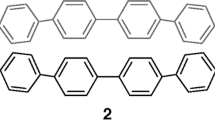Abstract
A fundamental question in inorganic crystallography is the relationship between chemical stoichiometry and crystal structure. The relationship between specific compounds and specific crystal structures is usually developed heuristically by surveying crystallographic data of known compounds. This process of structure-chemistry association has laid the historical foundation for identifying crystal structure prototypes and structural classifications. This paper demonstrates how informatics can quantitatively accelerate the discovery of structure—chemistry relationships but also be used as the foundation for developing structure—chemistry-property relationships.
Similar content being viewed by others
References
D.G. Pettifor, Structure Mapping Intermetallic Compounds: Principles and Practice, ed. J.H. Westbrook and R.L. Fleischer, Vol. 1 (Chichester, U.K.: John Wiley & Sons, 1995), pp. 419–438.
E. Mooser and W.B. Pearson, “On the Crystal Chemistry of Normal Valence Compounds,” Acta Cryst., 12 (1959), pp. 1015–1022.
W. Andreoni et al., “Hard-core Pseudopotentials and Structural Maps of Solids,” Phys. Rev. B, 20(12) (1979), p. 4814.
J.C. Phillips and J.A. Van Vechten, “Dielectric Classification of Crystal Structures, Ionization Potentials, and Band Structures,” Phys. Rev. Lett., 22(14) (1969), pp. 705–708.
K. Söerberg et al., “Crystal Structures and Phase Stability in Pseudobinary CaAl2−x Znx,” J. Solid State Chem., 179(8) (2006), pp. 2690–2697. Press, 1981), pp. 73–135.
D. Pettifor, Bonding and Structure of Molecules and Solids (Oxford, U.K.: Oxford University Press, 1995).
C. Suh and K. Rajan, “Establishing Measurement Techniques for Mapping Structure-Property Relationships,” Mat. Sci. Tech. (accepted).
L. Eriksson et al., Multi- and Megavariate Data Analysis—Principles and Applications (Ume Sweden: Umetrics Academy, 1999).
R.A. Johnson and D.W. Wichern, Applied Multivariate Statistical Analysis, 5th Ed. (Upper Saddle River, NY: Prentice Hall, 2002).
K.E. Sickafus, J.M. Wills, and N.W. Grimes, “Structure of Spinel,” J. Am. Ceram. Soc., 82(12) (1999), pp. 3279–3792.
W.Y. Ching et al., “Theoretical Prediction of the Structure and Properties of Cubic Spinel Nitrides,” J. Am. Ceram. Soc., 85(1) (2002), pp. 75–80.
P. Villars, “A Three-Dimensional Structure Stability Diagram for 998 Binary AB Intermetallic Compounds,” J. Less-Common Met., 92 (1983), pp. 215–238.
J.K. Burdett, G.D. Price, and S.L. Price, “Factors Influencing Solid-State Structure-An Analysis Using Pseudopotential Radii Structural Maps,” Phys. Rev. B, 24(6) (1981), pp. 2903–2912.
J.K. Burdett, G.D. Price, and S.L. Price, “Role of the Crystal-Field Theory in Determining the Structures of Spinels,” A. Am. Chem. Soc., 104 (1982), pp. 92–95.
H. Haeuseler, “Structure Field Maps for Sulfides of Composition AB2X4,” J. Solid. State. Chem., 86 (1990), pp. 275–278.
A. Zunger, “A Pseudopotential Viewpoint of the Electronic and Structural Properties of Crystals,” Structure and Bonding in Crystals, Vol. I, ed. M. O’Keeffe and A. Navrotsky (New York: Academic Press, 1981), pp. 73–135.
Y. Harada et al., “New Crystal Structure Maps for Intermetallic Compounds,” J. Phys.: Condens. Matter, 9 (1997), pp. 8011–8030.
P. Villars and J.C. Phillips, “Quantum Structural Diagrams and High-Tc Superconductivity,” Phys. Rev. B, 37(4) (1988), pp. 2345–2348.
C. Suh and K. Rajan, “Virtual Screening and QSAR Formulations for Crystal Chemistry,” QSAR & Comb. Sci., 24(1) (2005), pp. 114–119.
R.J. Hill, J.R. Craig, and G.V. Gibbs, “Systematics of the Spinel Structure Type,” Phys. Chem. Miner., 4 (1979), pp. 317–339.
R.D. Tobias, “An Introduction to Partial Least Squares Regression” (Cary, NC: SAS Institute Inc., 2007), http://support.sas.com/rnd/app/papers/pls.pdf.
V. Kholodovych et al., “Accurate Predictions of Cellular Response using QSPR: A Feasibility Test of Rational Design of Polymeric Biomaterials,” Polymer, 45(22) (2004), pp. 7367–7379.
M.D. Segall et al., “Population Analysis of Plane- Wave Electronic Structure Calculations of Bulk Materials,” Phys. Rev. B, 54(23) (1996), pp. 16317–16320.
R.M. Thompson and R.T. Downs, “Quantifying Distortion from Ideal Closest-Packing in a Crystal Structure with Analysis and Application,” Acta Crystallographica Section B, 57(2) (2001), pp. 119–127.
Author information
Authors and Affiliations
Corresponding author
Rights and permissions
About this article
Cite this article
Suh, C., Rajan, K. Informatics for chemical crystallography. JOM 61, 48–53 (2009). https://doi.org/10.1007/s11837-009-0009-7
Published:
Issue Date:
DOI: https://doi.org/10.1007/s11837-009-0009-7




